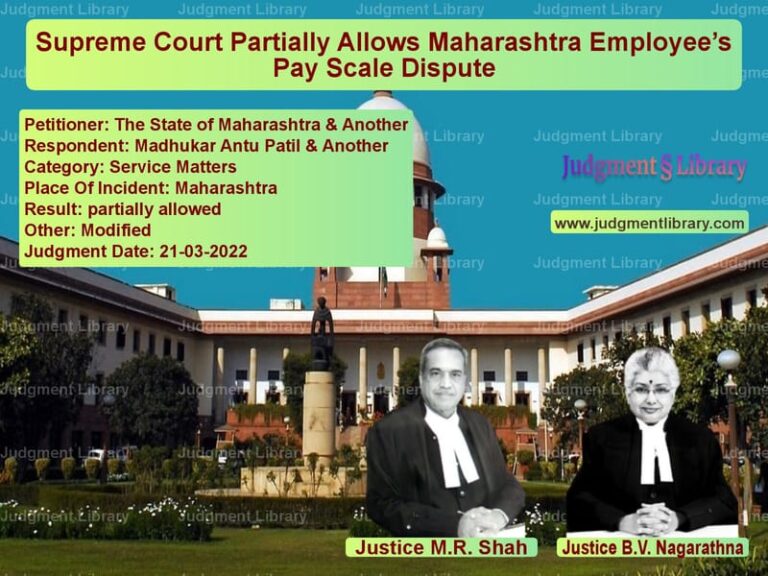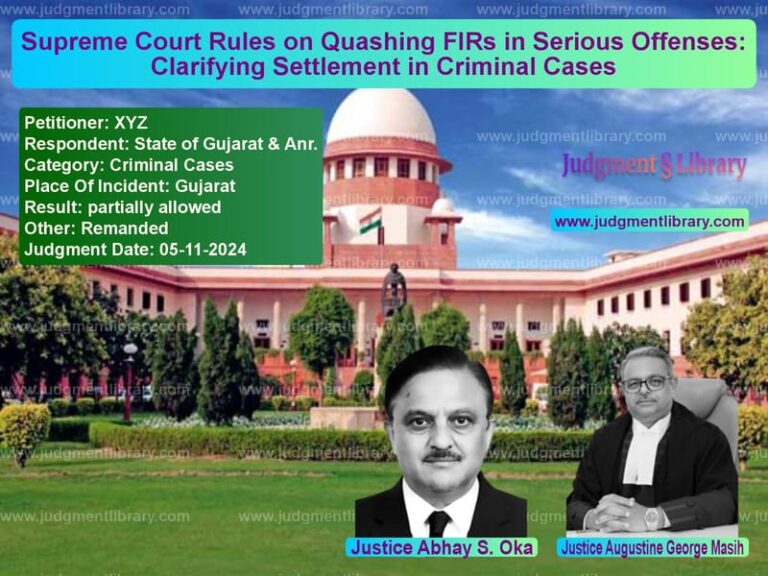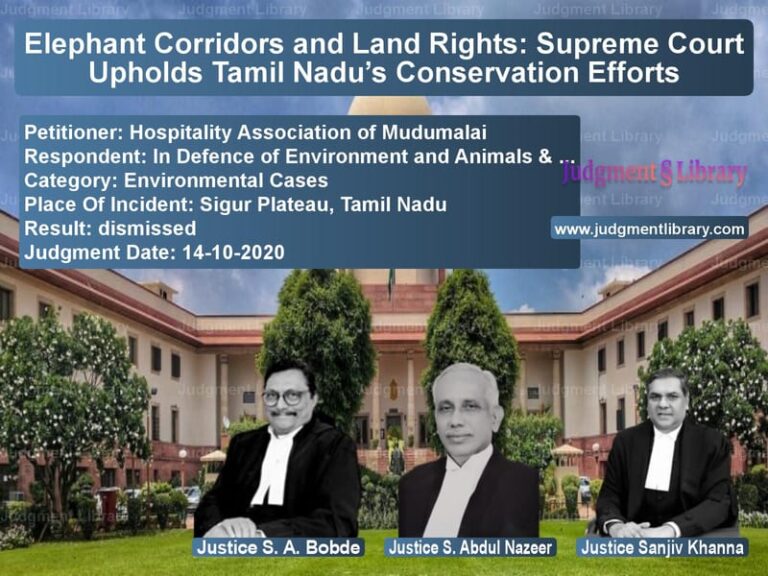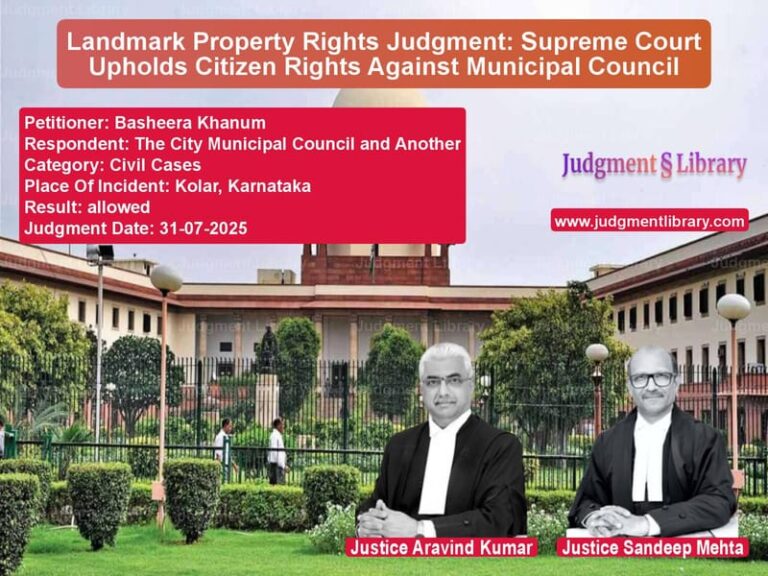Supreme Court Upholds Conviction in Murder Case: Kadamanian @ Manikandan vs. State
The case of Kadamanian @ Manikandan vs. State Represented by Inspector of Police involves the brutal murder and sexual assault of the victim, M. Jayalakshmi, leading to the conviction of the appellant under multiple provisions of the Indian Penal Code (IPC). The Supreme Court was called upon to evaluate whether the conviction was valid based on circumstantial evidence, extra-judicial confessions, and material recoveries. This judgment serves as a crucial precedent for understanding the admissibility of circumstantial evidence in criminal trials.
Background of the Case
The prosecution’s case was that on September 6, 2007, the victim, M. Jayalakshmi, went missing. Her father filed a missing person complaint the next day. On September 9, 2007, her body was discovered in a secluded area. Following an investigation, the appellant, Kadamanian @ Manikandan, was arrested. The police relied on an extra-judicial confession, recovery of stolen property, and forensic evidence to build their case.
Legal Issues Before the Supreme Court
- Whether the extra-judicial confession made by the appellant was admissible and reliable.
- Whether circumstantial evidence was sufficient to convict the appellant.
- Whether the recovery of stolen property linked the accused to the crime.
- Whether the co-accused’s acquittal should extend to the appellant.
Arguments by the Appellant
The appellant raised several key arguments:
- The case was based purely on circumstantial evidence without direct witnesses.
- The extra-judicial confession was not voluntary and should be excluded.
- The prosecution failed to establish a complete chain of events linking the appellant to the crime.
- The recovery of stolen property could not be directly linked to the crime.
- The co-accused was acquitted on similar evidence, and the same benefit should be extended to the appellant.
Arguments by the Respondent
The prosecution countered the appellant’s claims, arguing:
- The extra-judicial confession was voluntary and made before a credible witness.
- The recovery of the victim’s jewelry from the appellant’s possession proved his involvement.
- Forensic evidence corroborated the appellant’s involvement in the crime.
- The co-accused was acquitted due to lack of evidence against him, but there was sufficient proof against the appellant.
Supreme Court’s Observations
On Extra-Judicial Confession
“The extra-judicial confession was voluntarily made before a reliable authority and corroborated by other evidence. Its credibility is further strengthened by the appellant’s subsequent conduct.”
On Circumstantial Evidence
“The chain of circumstantial evidence, including forensic findings, recovery of stolen property, and the appellant’s behavior, establishes guilt beyond a reasonable doubt.”
On Recovery of Stolen Property
“The recovery of the victim’s jewelry from the accused at his instance forms a crucial link in the chain of evidence.”
On Acquittal of Co-Accused
“The acquittal of the co-accused was based on lack of evidence. The appellant, however, was convicted based on independent material linking him to the crime.”
Final Judgment
The Supreme Court upheld the conviction and awarded the following sentences:
- Life imprisonment for murder under Section 302 IPC.
- Seven years’ imprisonment for sexual assault under Section 376 IPC.
- Three years’ imprisonment for destroying evidence under Section 201 IPC.
- Three years’ imprisonment for misappropriation of property under Section 404 IPC.
All sentences were ordered to run concurrently.
Implications of the Judgment
- Admissibility of Extra-Judicial Confessions: The ruling reaffirms that extra-judicial confessions can be relied upon when corroborated by other evidence.
- Strength of Circumstantial Evidence: This case sets a precedent that a strong chain of circumstantial evidence is sufficient for conviction.
- Significance of Material Recoveries: The judgment highlights the importance of recoveries made at the instance of the accused.
- Independent Evaluation of Co-Accused: The acquittal of a co-accused does not automatically entitle another accused to the same benefit if independent evidence exists.
Conclusion
The Supreme Court’s decision in Kadamanian @ Manikandan vs. State Represented by Inspector of Police reinforces key principles of criminal jurisprudence. The ruling underscores the admissibility of extra-judicial confessions, the reliability of circumstantial evidence, and the significance of forensic analysis in securing convictions. This landmark case ensures that convictions are based on a complete and corroborated chain of evidence.
Don’t miss out on the full details! Download the complete judgment in PDF format below and gain valuable insights instantly!
Download Judgment: Kadamanian @ Manikan vs State Represented by Supreme Court of India Judgment Dated 31-08-2016-1741878617793.pdf
Direct Downlaod Judgment: Direct downlaod this Judgment
See all petitions in Murder Cases
See all petitions in Attempt to Murder Cases
See all petitions in Custodial Deaths and Police Misconduct
See all petitions in Judgment by Jagdish Singh Khehar
See all petitions in Judgment by Arun Mishra
See all petitions in dismissed
See all petitions in supreme court of India judgments August 2016
See all petitions in 2016 judgments
See all posts in Criminal Cases Category
See all allowed petitions in Criminal Cases Category
See all Dismissed petitions in Criminal Cases Category
See all partially allowed petitions in Criminal Cases Category







